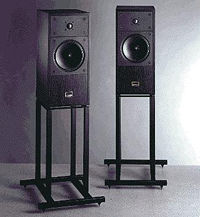The original Wharfedale Diamond was rumored to be the result of research for the company’s high-end TSR102 project, but it was actually just its treble and midrange unit housed in a tiny, handmade bass reflex box. The end result was a small loudspeaker with only 5.2 liters of internal volume to work with. A 19mm Audax plastic dome tweeter and Wharfedale’s proprietary 120mm long throw mid/bass driver with a (then reasonably sophisticated) polypropylene cone were included into this. It wasn’t a bad unit, with a sturdy steel frame that offered the Diamond a fighting chance of creating a decent noise.
Cabinets were made of thin 12mm chipboard with the required wood effect vinyl wrap. To give the Diamond some appearance of efficiency, a ducted port 30mm long and 65mm broad fired out of the back panel. The crossover was merely two components and a resistor to bring the tweeter level down, in true audiophile style from the 1980s. Let us not forget that only five years ago, no self-respecting loudspeaker could be found without a hideously complex, multi-element setup that drained more power than a Christmas morning oven. There were small binding posts on the back. As with practically every other inexpensive box of the time, there was an option of ‘wood effect’ vinyl or black vinyl wrap finishes.
The result was a tiny small loudspeaker, measuring only 240x185x205mm, that functioned with amplifiers ranging from 15 to 50W and had a (nominally) low impedance of 6 ohms. Its 86dB sensitivity meant that its 50W maximum input power would never sound particularly loud, but then again, if you wanted disco power, you’d purchase JBLs. Neither the bass nor the treble were very noteworthy; by roughly 75Hz, it had vanished!
That’s not a shocking collection of numbers, so why was the Diamond created in the first place? When you listened to a pair, you realized that you could have a pair of loudspeakers for under £80 that would transport you to the core of the song. They were bad in many hi-fi aspects – bass was noticeably absent, and treble extension and clarity were poor – but they were fantastic in terms of musicality. That polypropylene mid/bass unit was spotless enough to provide you with a view of the music that you simply had to peek through. The Diamonds made the most of their design advantages: small cabinets offered a quick, tight sound with minimal overhang, and tiny drivers meant near point-source imaging.
Wharfedale began altering the Diamond almost as soon as it was released in 1984. A year later, the Diamond IIs, which were more balanced and sober sounding, were released, followed by the Super Diamonds, which had stronger, real wood cabinets and veneer for nearly twice the price. The following Active Diamonds were ahead of their time because there were few audio sources with line level audio outputs back then, but there are now millions. Following that, a series of new Diamonds emerged, each with a narrower focus but superior all-around abilities than the originals. Buy the Is or IIs for roughly £50, depending on condition, and you’ll have some design masterpieces from the 1980s. It’s just plain fun.







